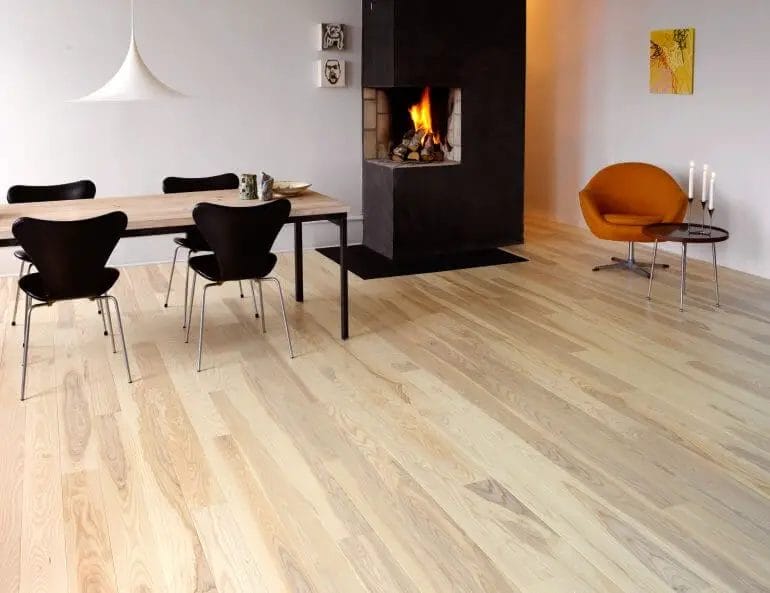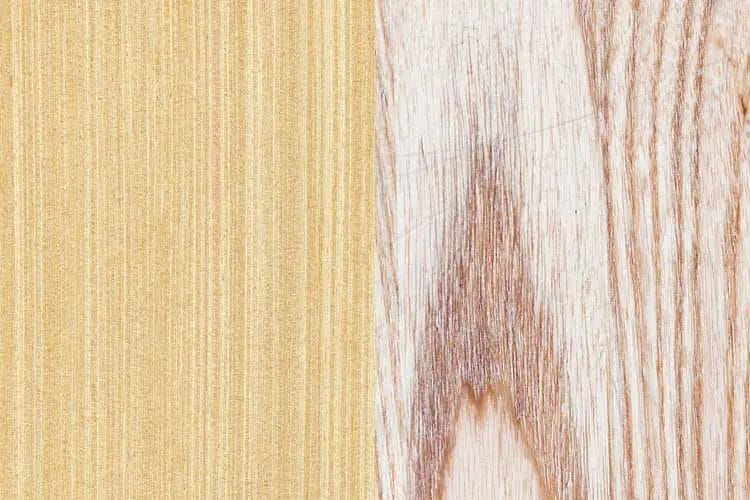Ash wood, known for its durability and attractive grain patterns, is a popular choice among furniture makers and carpenters. While prices can vary depending on factors such as quality, availability, and location, ash wood is generally considered affordable compared to other hardwoods. Its reasonable price, combined with its strength and versatility, makes it a popular option for both budget-conscious consumers and professionals in the woodworking industry.

Popular Uses of Ash Wood
Ash wood is a versatile and highly sought-after type of hardwood that is known for its strength, durability, and unique grain patterns. It has been used for centuries in various applications due to its excellent properties. In this section, we will explore some of the popular uses of ash wood.

Furniture
Ash wood is widely used in the manufacturing of furniture due to its strength and aesthetic appeal. It is particularly popular in the production of chairs, tables, cabinets, and bed frames. The light color and prominent grain patterns of ash wood lend a timeless and elegant look to furniture pieces. Additionally, its durability ensures that furniture made from ash wood has a long lifespan.
Flooring
Ash wood is an ideal choice for flooring due to its hardness and resistance to wear and tear. It can withstand high foot traffic and is less prone to scratching and denting compared to other types of wood. Ash wood flooring is available in various finishes, ranging from natural to stained, allowing homeowners to choose the perfect look for their space. Its light color also helps to create a bright and airy atmosphere in a room.
Cabinetry
Ash wood is commonly used in the construction of cabinets for kitchens, bathrooms, and storage areas. The wood’s natural strength and stability make it an excellent choice for building durable and functional cabinetry. Ash wood cabinets can withstand heavy use and provide ample storage space for everyday necessities. The light color of ash wood also complements various kitchen and bathroom designs.
Doors and Windows
Ash wood is often used for the production of doors and windows due to its strength and stability. It is resistant to warping, which ensures that doors and windows made from ash wood will fit properly and remain functional over time. The wood’s natural insulating properties also contribute to energy efficiency in buildings.
Sports Equipment
Ash wood is highly valued in the manufacturing of sports equipment, especially baseball bats and hockey sticks. Its strong and flexible nature makes it an ideal choice for these applications. Ash wood baseball bats, in particular, are known for their excellent performance and durability. The wood’s lightweight characteristics also contribute to improved handling and swing speed.
Guitar Making
Ash wood is a popular choice among guitar makers due to its tonal qualities. Electric guitars made with ash bodies are known for their bright and resonant sound. The wood’s ability to sustain notes and its balanced tonal response make it a preferred option for many guitarists.
Architectural Millwork
Ash wood is extensively used in architectural millwork due to its versatility and workability. It can be easily shaped, carved, and turned to create intricate designs and details. Ash wood is often used for moldings, trim, paneling, and other decorative elements in residential and commercial buildings.
Woodworking Crafts
Ash wood is highly sought after by woodworkers and craftsmen for a variety of projects. Its strength, durability, and attractive grain patterns make it a popular choice for creating handcrafted items such as bowls, cutting boards, spoons, and other wooden crafts. The light color of ash wood also allows for easy staining and finishing to achieve desired aesthetics.
In summary, ash wood is a versatile and highly desirable hardwood that finds its applications in various industries. From furniture and flooring to sports equipment and musical instruments, ash wood’s strength, durability, and aesthetic qualities make it a preferred choice for many craftsmen and manufacturers.

Factors Affecting the Price of Ash Wood
Ash wood is a popular choice for furniture, flooring, and other woodworking projects due to its strength, durability, and appealing grain patterns. However, when it comes to purchasing ash wood, the price can vary significantly. Several factors influence the price of ash wood, and it is essential to understand these factors to make an informed decision. In this section, we will explore the key factors that affect the price of ash wood.
1. Quality of the Wood
The quality of ash wood plays a significant role in determining its price. High-quality ash wood is characterized by straight and even grain patterns, minimal knots, and uniform color. Wood with these features is aesthetically pleasing and more desirable for woodworking projects. As a result, it commands a higher price compared to lower-quality ash wood that may have irregular grain patterns, knots, or discoloration.
2. Grade of the Wood
Ash wood is graded based on its appearance and structural qualities. The grading system categorizes ash wood into different grades, such as select grade, common grade, and rustic grade. Select grade ash wood is of the highest quality, with minimal defects and uniform appearance. On the other hand, rustic grade ash wood may have more noticeable defects but can still be suitable for certain projects. The grade of the wood directly impacts its price, with higher grades commanding a premium.
3. Availability and Demand
The availability and demand for ash wood also influence its price. If ash wood is readily available in the market, the price may be lower due to higher supply. However, if there is limited availability or high demand for ash wood, the price is likely to increase. Factors such as seasonal fluctuations, environmental regulations, and market conditions can affect the availability and demand for ash wood, thereby impacting its price.
4. Geographic Location
The geographic location where the ash wood is sourced can affect its price. Transportation costs, import/export regulations, and regional market dynamics can influence the price of ash wood in different regions. For example, if ash wood needs to be imported from a distant location, the transportation costs can increase the overall price. Similarly, if ash wood is sourced from a region with high demand or limited supply, the price may be higher.
5. Processing and Finishing
The level of processing and finishing applied to ash wood can also impact its price. Raw, untreated ash wood is generally more affordable compared to processed or finished wood. Additional processes such as kiln drying, sanding, and applying protective coatings can increase the price of ash wood. The type and quality of the finishes used can also affect the price, with premium finishes commanding a higher cost.
6. Size and Shape
The size and shape of ash wood can influence its price as well. Larger and thicker pieces of ash wood are often more expensive due to higher material costs and the difficulty of handling and processing them. Similarly, certain shapes or cuts, such as wide planks or specialty shapes, may command a premium price due to the additional effort required during manufacturing.
7. Market Conditions
Lastly, market conditions have a significant impact on the price of ash wood. Economic factors, fluctuations in the housing and construction industry, and global trade dynamics can all influence the supply and demand for ash wood, thereby affecting its price. It is crucial to stay informed about market trends and conditions to make informed purchasing decisions.
In summary, the price of ash wood is influenced by several factors, including the quality and grade of the wood, its availability and demand, geographic location, processing and finishing, size and shape, and market conditions. By considering these factors, individuals can better understand the pricing variations in ash wood and make informed decisions when purchasing it for their woodworking projects.

Comparing the Cost of Ash Wood with Other Types of Wood
When it comes to choosing wood for your next project, cost is definitely a factor to consider. Different types of wood come with different price tags, and it’s important to compare them so you can make an informed decision. In this section, we will discuss the cost of ash wood in comparison to other types of wood.
Ash wood is a popular choice among woodworkers and furniture makers due to its desirable characteristics. It is known for its strength, durability, and beautiful grain patterns. However, before diving into the cost, it’s important to note that wood prices can vary depending on factors such as location, availability, and quality.
Now, let’s compare the cost of ash wood with other commonly used types of wood:
Oak Wood
Oak wood is widely used in furniture making and construction. It is known for its durability and attractive grain patterns. In terms of cost, oak wood is generally more expensive than ash wood. This is partly due to its popularity and the demand for oak products in the market.
Maple Wood
Maple wood is another popular choice for furniture and cabinetry. It is known for its light color and smooth grain. In terms of cost, maple wood can be slightly more expensive than ash wood, depending on the quality and availability. However, it is still considered a relatively affordable option for woodworking projects.
Cherry Wood
Cherry wood is highly sought after for its rich color and natural beauty. It is often used in high-end furniture and custom cabinetry. When comparing the cost, cherry wood tends to be more expensive than ash wood. The limited availability and the time-consuming process of harvesting and drying cherry wood contribute to its higher price.
Pine Wood
Pine wood is a popular choice for budget-friendly projects and rustic designs. It is known for its light color and soft texture. In terms of cost, pine wood is generally more affordable than ash wood. Its abundance and fast growth rate make it a cost-effective option for various woodworking applications.
It’s important to keep in mind that the cost of wood can fluctuate over time due to factors such as market demand, availability of resources, and economic conditions. Additionally, the cost can vary depending on the grade and quality of the wood.
In summary, when comparing the cost of ash wood with other types of wood, it is generally a more affordable option than oak, maple, and cherry wood. However, it is important to consider other factors such as the specific project requirements, desired aesthetics, and the availability of the wood in your area before making a final decision.
Tips for Buying Ash Wood at a Reasonable Price
If you are planning to buy ash wood for your home or project, it’s important to ensure that you get the best quality at a reasonable price. Ash wood is known for its strength, durability, and beautiful grain patterns, making it a popular choice among homeowners and furniture makers. However, it’s also important to keep in mind that the price of ash wood can vary depending on various factors. To help you make an informed decision, here are some useful tips for buying ash wood at a reasonable price.
1. Research and compare prices
Before making a purchase, it’s always a good idea to research and compare prices from different suppliers. Look for local lumberyards, online retailers, or wholesalers that offer ash wood. Take note of the prices and make a comparison to find the best deal. Keep in mind that prices may differ based on the quality of the wood, size, and availability.
2. Consider buying in bulk
If you are planning to use a large amount of ash wood, consider buying in bulk. Many suppliers offer discounts for bulk purchases, which can help you save money in the long run. Buying in bulk also ensures that you have enough wood for your project, as matching the exact color and grain pattern of ash wood can be challenging if you run out.
3. Check for discounts or promotions
Keep an eye out for discounts or promotions offered by suppliers. Some suppliers may have seasonal sales or clearance events, where you can find ash wood at a discounted price. Additionally, sign up for newsletters or follow suppliers on social media to stay updated on any special offers.
4. Inspect the wood for quality
Before finalizing a purchase, it’s essential to inspect the quality of the ash wood. Look for any cracks, knots, or other defects that may affect its durability or appearance. Ensure that the wood is straight, without any warping or twisting. By carefully examining the wood, you can ensure that you are getting the best value for your money.
5. Consider alternative sources
If you are on a tight budget or having trouble finding reasonably priced ash wood, consider alternative sources. Look for reclaimed ash wood from old structures, barns, or furniture. Reclaimed wood not only offers a unique character but is also an eco-friendly choice. You can often find reclaimed ash wood at a lower price compared to newly harvested wood.
6. Negotiate and communicate
Don’t be afraid to negotiate with suppliers. If you have found a suitable supplier but the price is slightly higher than your budget, communicate with them and see if they are open to negotiation. They might be willing to offer a discount or work out a deal that suits both parties. Building a good rapport with suppliers can also benefit you in the long run.
7. Consider the long-term benefits
While price is an important factor, it’s also crucial to consider the long-term benefits of buying ash wood. Ash wood is known for its durability, resistance to wear, and ability to withstand heavy use. Investing in high-quality ash wood may save you money in the long run, as it will require less maintenance and replacement compared to lower-quality alternatives.
In summary, buying ash wood at a reasonable price requires some research, comparison, and consideration of various factors. By following these tips, you can ensure that you get the best quality ash wood at a price that fits your budget, allowing you to create beautiful and long-lasting furniture or projects.
Frequently Asked Questions
Is ash wood expensive?
The cost of ash wood can vary depending on the quality, availability, and demand. Generally, ash wood is considered to be moderately priced compared to other hardwoods. However, prices can fluctuate based on factors such as location and market conditions.
Conclusion
In conclusion, the price of ash wood can vary depending on various factors such as quality, availability, and demand. While it may not be the most expensive wood on the market, it is generally considered to be in the mid-range in terms of cost. However, it is important to note that prices can fluctuate over time and vary from region to region. Despite its price, ash wood is highly valued for its durability, versatility, and attractive grain patterns. Whether you are looking to use it for furniture, flooring, or cabinetry, ash wood remains a popular choice for its combination of affordability and aesthetic appeal.